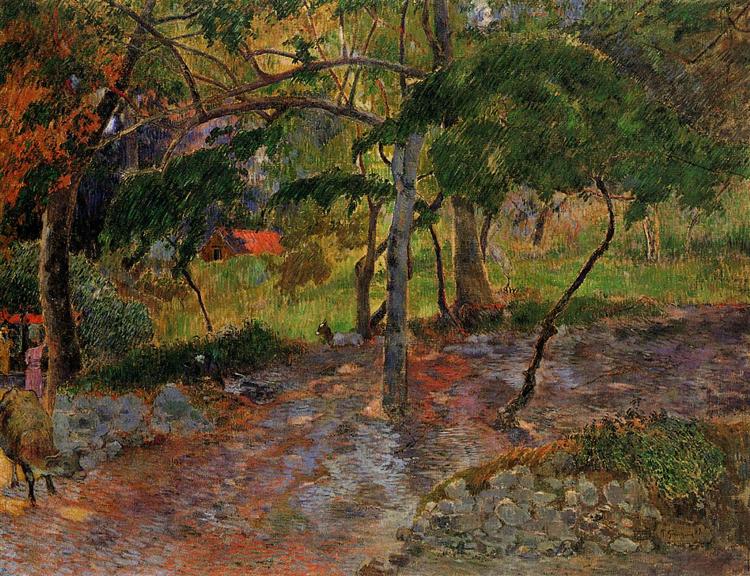Description
Paul Gauguin's "Tropical Landscape - Martinique - 1887" represents a pivotal moment in the evolution of post-impressionist art and the search for a new aesthetic that would elude the conventions of European academicism of the time. In this painting, Gauguin immerses himself in the rich life and vibrant environment of the West Indies, specifically Martinique, where he spent significant time, seeking inspiration from a culture and landscape that he considered more authentic and primal.
The painting is a visual testament not only to Martinique’s scenic beauty, but also to Gauguin’s interest in tropical light, which is evident in his treatment of colour. The palette used is rich and bold, with lush greens, warm yellows and deep blues predominating, evoking the feeling of a warm and vibrant climate. Gauguin was not content with depicting the island’s flora and fauna accurately; instead, he used colour symbolically to evoke moods and sensations that transcend mere literal representation, focusing on creating an atmosphere that invites contemplation.
The composition of the painting is notable for its balanced structure. In the foreground, the tropical landscape features dense vegetation that stretches across the work, giving a sense of depth and texture. In the background, a mountain range can be discerned, providing a sense of place and location. It is interesting to note how the curvilinear lines of the leaves and the organic shapes of the trees guide the viewer's gaze and add a sense of movement. This fluidity is characteristic of Gauguin's style, who sought to break away from the rigidities of traditional art, leaning toward greater personal expression.
Particularly intriguing is the absence of human figures in the work, which could be interpreted as a deliberate decision by the artist. Rather than focusing on the lives of the people who inhabit the landscape, Gauguin prefers to focus on the natural environment and its intrinsic beauty. However, it is possible to relate this work to his later interest in the representation of indigenous peoples and their culture, which would become more evident in later works such as those he made in Tahiti. The influence of these experiences on his creative process is undeniable, marking a path towards an art that reflects both the artist's personal experience and his fascination with cultures other than European.
It is important to contextualize "Tropical Landscape - Martinique - 1887" within the tendency of post-impressionist painters towards the simplification of forms and the exploration of emotionality through color. Compared to other contemporary works, this painting stands out for its ability to evoke the essence of a place without falling into a strict representation, which places Gauguin in a vanguard position in the development of a more symbolic and expressive art.
Alongside his experiences in Martinique, Gauguin anticipates his dissatisfaction with European capitalist life and his search for a more "primitive" ideal of life, a common trait among many of his contemporaries. Through this work, the viewer is invited to experience a visual pleasure that transcends direct representation, connecting with the land and the spirit that resides within it, while exploring the complex relationship between the artist, his environment and his perception of the world. "Tropical Landscape - Martinique - 1887" not only captures a captivating landscape, but also a moment in which Western art was beginning to expand its horizon towards new influences and territories.
KUADROS ©, a famous painting on your wall.
Hand-made oil painting reproductions, with the quality of professional artists and the distinctive seal of KUADROS ©.
Painting reproduction service with satisfaction guarantee. If you are not completely satisfied with the replica of your painting, we will refund 100% of your money.

